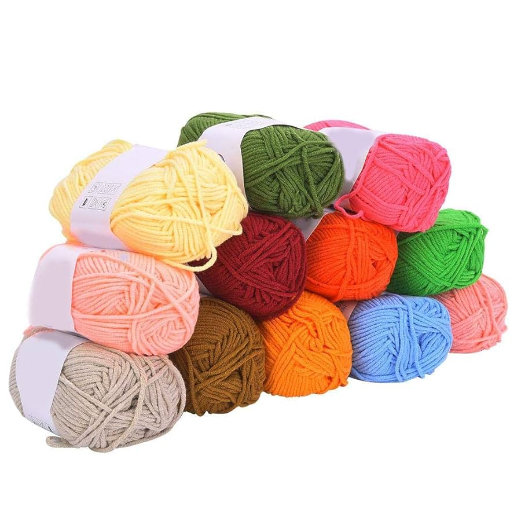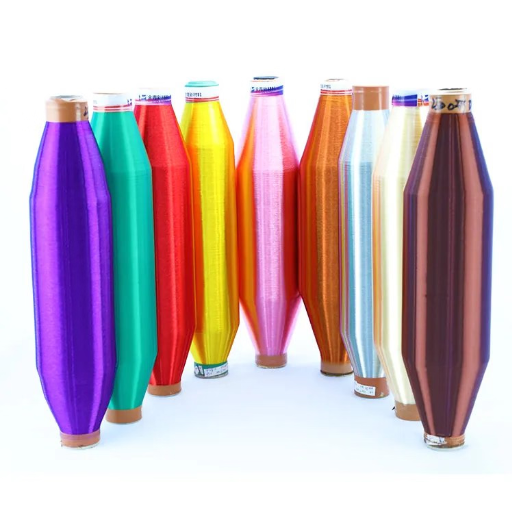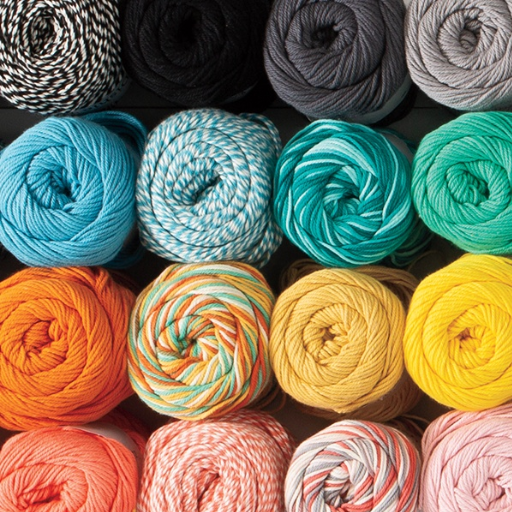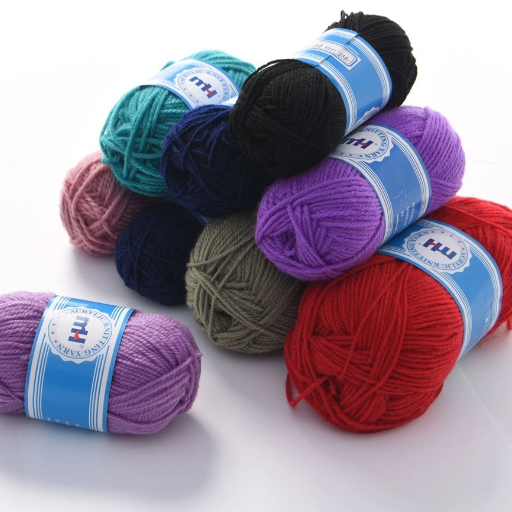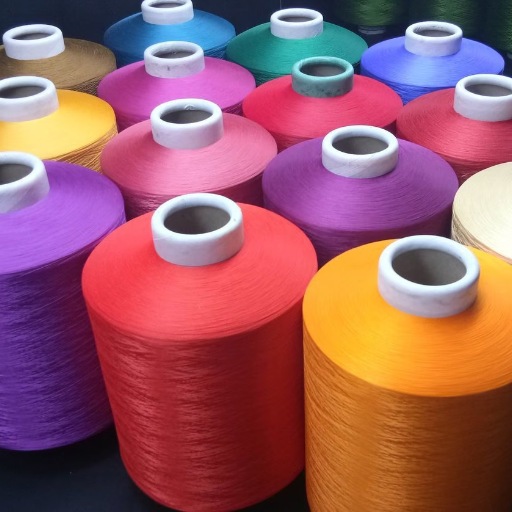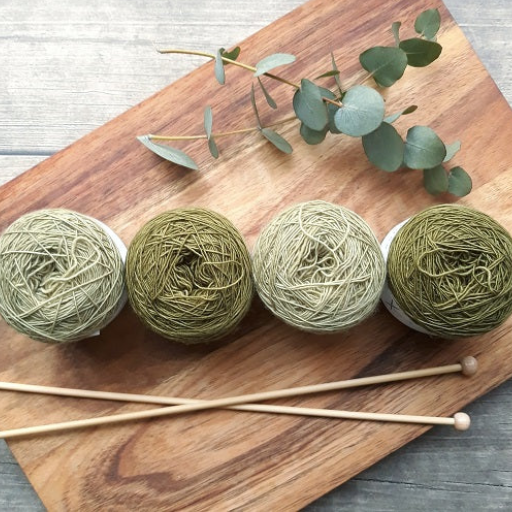Thread selection is crucial in achieving smooth, long-lasting, and professional finishes for any sewing project. Both experts and novices admire the versatility of Gutermann Sew-All Polyester Thread in 701 (CA02776). In this blog post, I will describe in detail this thread’s technical specifications along with its practical and value-added uses with different kinds of fabrics. Its superior strength, smooth finish, and compatibility with most sewing machines make this industrial-grade thread ideal for intricately crafted garments, upholstery, or simple mending tasks. Get its smooth finish make hassle-free stitches with ease and get value for your money. Stay tuned to find out why this thread is every sewing lover’s dream and every sewing professional’s best friend.
What Makes Gutermann Sew-All Polyester Thread Stand Out?

The unique strength, durability, and smoothness of Gutermann Sew-All Polyester Thread fibers enable Ideal stitching. It is made from 100% polyester which makes it ideal for a wide range of activities as it does not frail, shrink, or fade in color. Its structure is uniform which provides even thread tension and decreases the risk of breakage during hand or machine sewing. Moreover, the compatibility with a wide range of fabrics, from fragile silk to strong denim, sets it as a versatile option for beginners and professionals alike. With these qualities, this thread has gained unmatched popularity in the sewing community.
Why is polyester thread preferred for sewing?
Polyester threads have gained immense popularity in the sewing sector because they are very strong and flexible, resisting wear and tear exceptionally well. Unlike natural fibers, polyester will not shrink, become overly stretched, or weakened from moisture exposure which makes it ideal for decorative and garment stitching. Polyester’s non-loose and non-linty texture guarantees that there is no snagging or breakage during hand or machine sewing so that the tension remains constant. Also, colorfast polyester threads ensure that colors remain bright and unchanged, and the thread does not lose functionality over washing or exposure to the sun. All of this, along with its ability to work on multiple types of fabrics ranging from lightweight chiffons to heavy-duty canvas and the ability for high-stress applications, cements the use of polyester threads among sewing professionals and enthusiasts.
What are the benefits of using Gutermann sew-all?
Gutermann Sew-All Thread is advantageous because of its quality and flexibility. Made from 100% polyester, it is both strong and elastic, thus it can withstand breaking during machine or hand sewing, In addition, Gutermann Sew-All can be used for almost any fabric, from delicate silks to heavy-weight fabrics. Its threads are also colorfast, meaning it can be washed or exposed to sunlight or friction without losing its vibrant hues. Because of these many advantages, Gutermann Sew-All caters to professionals as well as hobbyists.
How does the CA02776 thread enhance your sewing projects?
By providing unmatched strength, flexibility, accuracy, and ease in sewing, the CA02776 thread is a perfect addition to sewing projects. Made from premium-grade polyester, this thread is very durable so it can be used in tough sewing and everyday sewing tasks. Its smooth texture reduces the chances of stitch forming lint, thus resulting in smooth stitches, and minimizes machine jams or skipped stitches. Also, CA02776 thread works well with various fabrics from light materials to heavy-duty cloths, assuring accurate performance in different tasks. Threads are also color-stable, which protects them from losing color with frequent washing, exposure to sunlight, or friction, guaranteeing great value and a professional appearance for any project.
How to Choose the Right Sewing Thread for Your Projects?

Choosing the right sewing thread can be a daunting task, especially when you haven’t considered some of the most crucial factors. Firstly, you need to know the type of fabric you will be using. A lightweight fabric goes hand in hand with a fine thread while a durable fabric would require a tougher, thicker thread. We then shift to considering the thread material. For instance, polyester threads like CA02776 are useful and durable for many applications whereas cotton threads work well with natural fabrics. The thread has to match the fabric for a seamless look which best can either be the exact color or a couple of shades darker. Lastly, check that the thread goes with the sewing machine to help avoid intervals or damage while sewing. Taking these factors into account will help ensure an appealing structural finish, meticulous and flawless.
What factors should you consider when selecting a thread?
Selecting the perfect thread requires one to consider multiple issues that guarantee proper results both aesthetically and practically. One of the factors to consider is the type of fabric used: delicate fabrics require fine threads, while coarse ones need thick, stronger threads to ensure durability. Another consideration to be kept in mind is the type of thread: polyester threads have multiple applications and can be used with most fabrics, while cotton threads work best with natural fibers as they have the lowest elasticity. Such specialized fabrics like elastic or upholstery do require more specialty threads meant for such fabrics. Another consideration is that of color; one should always use a color that harmonizes the most with the fabric being used or even is a shade darker. Moreover, there is a need to ensure that the thread is compatible with the sewing machine being used too. One of the last things to be considered is the purpose the thread is to be used for: ornamental stitching, functional seams, or seemingly high-tension seams.
How does thread size impact your sewing?
The size of the thread is crucial not just to the sewing’s strength and appearance, but also to the quality of the whole project. Larger threads usually have higher tensile strength and therefore can be utilized in heavy-duty projects such as upholstery or leather works where the strongest durability is required. On the other part, smaller sizes of threads are better for lighter fabrics and more elaborate stitches which need finer seams that wouldn’t distort or damage the fabric. Smaller thread sizes also help when finer details such as delicate stitches need to be formed. Additionally, thicker threads may require a larger needle size or machine’s tension to form stitches consistently. The size of the thread should correspond to the fabric’s weight; when there is a mismatch, issues like puckering, breakage, and poor aesthetic appeal arise. To get maximum compatibility with the fabric, sewing machine settings, and purpose of the finished product, it is crucial to select the proper thread size.
Why is color and shade selection important?
Differently colored threading can be highly instrumental when it comes to completing a sewing project. Top-stitching or revealing seam threads should blend well with the fabric, so the shade of thread should either match or complement the material. Failure to do so will cut the visual appeal and harmony of the product being designed. In addition, the aesthetic of the design can be altered by minor changes in lighting; therefore, using natural light to test the thread colors is suggested. There are instances when contrasting threads may be employed for purely decorative purposes, but it must be done skillfully so that the proper shade is selected to match the design. When it comes to functional design work, using UV or fade-resistant dyes will ensure the product is visually appealing for much longer.
How to Use Gutermann Sew-All Thread with Your Sewing Machine?

Using Gutermann Sew-All Thread with your sewing machine ensures optimal performance and professional-quality stitching. Begin by selecting the appropriate spool size and threading it correctly onto your sewing machine. Consult your machine’s manual for specific threading instructions, ensuring both the upper thread and the bobbin thread are securely in place. Adjust the tension settings as needed, as improper tension can cause thread breakage or uneven stitching. Test the setup on a fabric scrap to confirm smooth operation before starting your project. Regular machine cleaning and maintenance also aid in achieving consistent results with the Gutermann thread, prolonging both the machine’s and the thread’s performance.
What is the correct way to thread your sewing machine?
To make certain your sewing machine functions seamlessly and stitches beautifully, threading it correctly is a crucial first step. First, raise the presser foot and turn the handwheel until the needle is at the utmost pinnacle. Next, place the spool of thread on the spool pin, verify it is secure, and tug the thread through the thread guide of the sewing machine. Drawing the thread along the indicated threading path on your machine, continue to guide it through the tension discs and other thread guides. Pull the thread through the take-up lever followed by the remaining guide loops leading to the needle. Now you can finally thread the needle front to back which will depend on your machine model, some machines are different. When you are finished, draw the needle and bobbin thread beneath the presser foot with a remaining thread tail visible of 4-6 inches. As always, your machine’s manual should be your go-to source of information since threading methods differ per model. In conclusion, proper threading avoids machine problems such as tangling, skipping stitches, or inefficient stitching altogether.
How do you adjust the tension for the polyester thread?
For adjusting the tension on the polyester thread, always start with a test using fabric and thread, and cut a sample off a larger piece of material Puse. As a general guidance, set the upper tension dial on your machine to between 4 and 5. Confirm the stitches or adjust them. If the stitches seem too tight, causing some puckering or breakage of the thread, lower the tension gradually. If the stitches are slack or on the rough side, increase the tension until even stitching is reached. Also make sure that the bobbin’s tension is properly set, which should not be too much trouble for most machines when set correctly. Check the head of the needle against the stitch and thread and if there are still problems, completely rethread the machine. To learn more about the specific device, use the manual, since different devices have different tension adjustments. Balanced tension guarantees even and smooth stitches in the fabric which gives them a professional look.
Is there a specific needle size you should use?
Indeed, the size of the needle you opt for relies upon the fabric type and weight, along with the thread thickness. Delicate fabrics such as silk or chiffon require smaller needles, sizes 60/8 or 70/10. Medium-weight cotton, denim, and linen fabrics are better suited to needles sized between 80/12 and 90/14. Heavier materials such as canvas or upholstery fabric require the use of larger needles, sizes 100/16 and above. In addition, ensure that the needle type is compatible with the fabric: universal needles are less specialized but much more useful, ballpoint needles are used for knits, and sharp needles are better for wovens. For best results on stitching quality, always check the sewing machine manual or needle guide.
What Projects Are Ideal for Gutermann Sew-All Polyester Thread?

Gutermann Sew-All Polyester Thread is fitting for sewing projects ranging from light crafts to home décor projects and even furniture upholstery. It is also perfect for quilting, as it provides smooth stitching and dependable durability. This thread works optimally with both woven and knit fabrics, and thus, is ideal for garment construction. Its all-purpose nature makes it an excellent option for both beginners and advanced sewists.
Which Fabrics Work Best with Polyester Thread?
Polyester blends and other synthetic fabrics work well with polyester thread, as the chances of optimal compatibility and strength are very high. Aside from that, this type of thread also works great with natural fabrics like cotton, which makes it ideal for medium and lightweight clothes. Because it has some elasticity and durability, Polyester thread does well when used on stretchy fabrics like knit or elastane blend textiles. Overall, the thread’s consistent performance and adaptability across a wide range of both natural and synthetic textiles make it a reliable choice for effortless stitching.
Can Gutermann Sew-All Be Used for Decorative Sewing?
Absolutely. Gutermann Sew-All thread is not only suitable for sewing but can also serve as an effective option for decorative sewing. Because of its high-quality, polyester composition, the thread provides a smooth and even finish which is ideal for decorative stitches, embroidery, and even embellishments. The thread is designed in a way that ensures constant tension and reduces the chances of breakage, which is important for delicate or aesthetic stitching. Moreover, its slight sheen increases beautification which is particularly useful in projects that require an elegant finish. Because of this, Gutermann Sew-All is a reliable choice for both functional as well as decorative sewings.
How does polyester thread perform in overlock stitching?
Because of its strength, durability, and elasticity, the polyester thread performs exceptionally well in overlock stitching. Furthermore, it is highly recommended for overlock stitching due to its smooth texture which ensures proper threading and reduces breakage during stitching, especially at high speeds which is very common in serging. It is also true that polyester thread tends to stretch under the burden of overlock stitches, which makes it ideal for use in forming secure and stretchable seams on knit and other stretchy fabrics. It also does not shrink, fade, or get abraded, which prolongs the finished seams, even with severed washing and wearing. This makes polyester thread the most preferred option for overlock stitching in many garment constructions and finishing applications.
Understanding the Different Spool Sizes and Yards Available

Understanding the various spool sizes and yard lengths available is crucial when it comes to choosing polyester thread for overlock stitching. Polyester threads come in the form of cones or spools, with the smaller spools containing 200 to 500 yards of thread, while the larger cones can hold up to 6000 yards or more. For household purposes or infrequent sewing, smaller spools are preferable. Larger cones are better for industrial uses or when undertaking massive sewing projects. The right spool size will depend on the scope of your work, and larger cones will minimize rethreading the spool which enhances production efficiency. In overlock stitching, matching your threads to your project requirements provides maximum efficiency.
What is the significance of the 100m spool?
As it is primarily designed for small or personal sewing projects, the 100m spool is of particular importance. Its small size renders it economical and helpful for hobbyists or casual users who do not need vast quantities of thread. Furthermore, the 100m spool is ideal for more delicate tasks such as mending, crafting, or testing new stitch patterns without the need to purchase larger cones. This spool size offers just the right amount of thread for smaller tasks, thus reducing wastage while also making it easier to store and carry around. The 100m spool may not have great lengths of thread, but it has the same quality and strength as larger spools, making it reliable for detailed and precise sewing projects.
Are there larger cone options for extensive projects?
Yes, larger cones are available for particular uses and applications. Many suppliers of traffic safety materials and construction equipment provide cones that range from 28 inches to 42 inches, and some manufacturers even make custom and oversized cones. These larger traffic cones are often constructed with PVC or rubber to withstand difficult environments and are created with reflective strips or bright paint to improve visibility. To order, it is recommended to check Grainger, TrafficSafetyWarehouse.com, or TheTrafficSignStore.com, as they allow bulk purchases and these companies cater to large projects.
How do you manage thread stash effectively?
To organize materials and make them easy to access, the system of managing a thread stash must be carried out in a specific detailed orderly manner. Establishing an order for your embroidery, sewing, and specialty threads according to their type, color, and purpose should be the first step. Threads can be tangled up and become invisible which is why they must be separated and placed into transparent boxes, thread racks, or even spool cases. To further speed up the process of identification, the storage containers must be labeled while an older first-in, first-out system should be adopted to stop the deterioration of your older threads. Humidity and direct sunlight must be avoided as much as possible to avoid degradation of thread quality with time. From time to time, an efficient check of your collection can be made to get rid of unusable leftover spools. A log can be maintained to note down all the thread types and quantities to keep an eye on their usage and to avoid over-purchasing. This approach will guarantee maximal use while also greatly improving the longevity of your thread stash.
References
Frequently Asked Questions (FAQ)
Q: What is the Gutermann Sew-All Polyester Thread and its main use?
A: The Gutermann Sew-All Polyester Thread is a versatile sewing machine thread designed for machine sewing and hand stitching. It is known for its strength and durability, making it suitable for all types of fabrics and seams.
Q: How does the Gutermann Sew-All Thread 100m differ from cotton thread?
A: Unlike cotton thread, the Gutermann Sew-All Thread 100m is made from polyester, providing a stronger and more durable finish. It is less prone to fiber lint and seam crimping, ensuring a smooth and clean seam.
Q: Why is Gutermann Thread considered essential for crafters?
A: Gutermann Thread is considered essential because of its high-quality construction, making it suitable for a wide range of crafts, including embroidery and machine sewing. It ensures uniform stitching without fiber lint and seam crimping.
Q: Can you explain the thickness and weight of the Gutermann Sew-All Polyester Thread Spool?
A: The Gutermann Sew-All Polyester Thread Spool is typically a 40wt thread, meaning it is of medium thickness. This makes it ideal for various sewing projects, from lightweight fabrics to heavier materials.
Q: What are the benefits of using the Gütermann Creativ collection for machine embroidery?
A: The Gütermann Creativ collection offers a wide range of colors and finishes, allowing for creativity in machine embroidery. The threads are smooth and provide a lustrous finish, making them particularly suitable for decorative stitching.
Q: How can I select the right color of Gutermann Thread for my project?
A: To select the right color, consider the fabric and the desired effect. Gutermann offers an extensive palette, ensuring you can find the exact shade needed for your project. It’s important to match the thread color closely to the fabric for a seamless finish.
Q: What is the description of the Gutermann Sew-All Thread 100m spool?
A: The Gutermann Sew-All Thread 100m spool is a high-quality, all-purpose thread made from polyester. It measures 110 yards (or 100 meters) and is suitable for both machine sewing and hand stitching on various fabrics.
Q: Is the Gutermann Sew-All Polyester Thread suitable for top stitch and button applications?
A: Yes, the Gutermann Sew-All Polyester Thread is strong and durable, making it ideal for top stitch and button applications, where a robust seam is crucial.
Q: What should I do if I need to return a Gutermann Thread spool?
A: If you need to return a Gutermann Thread spool, check the store’s return policy where you purchased it. Ensure the spool is in its original condition and packaging for a successful return.









